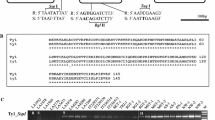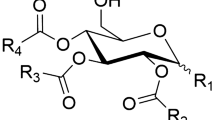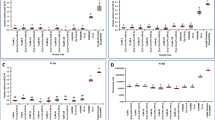Abstract
Acylsugars exuded from type IV trichomes mediate the multiple pest resistance found in the wild tomato species, Lycopersicon pennellii. A marker-assisted selection breeding program was used to attempt the transfer of the ability to accumulate acylsugars to cultivated tomato. RFLP and PCR-based markers were used through three backcross generations to select plants containing 5 target regions associated by QTL analysis with acylsugar accumulation. The BC1F1 plant selected possessed all 5 target regions and accumulated acylsugars at a moderate level similar to that of the interspecific F1 control. The BC2F1 and BC3F1 selections contained complementary subsets of the 5 target regions and did not accumulate acylsugars. BC3F1 plants with complementary subsets of the 5 target regions were intermated to produce populations segregating for the 5 target regions. From 1000 BC3F1-intermated plants, three plants were found which accumulated acylsugars at low levels and contained 3 to 5 of the target regions. The recovery of acylsugar accumulation in progeny of the intermated BC3F1 plants supports the involvement of at least some of the 5 target regions in acylsugar biosynthesis. However, since the levels of acylsugars accumulated by these plants were lower than that of the interspecific F1, it is likely that another, as of yet unidentified, region is necessary for accumulation of higher levels of acylsugars.
Similar content being viewed by others
References
Alpert KB, Grandillo S, Tanksley SD: fw2.2: a major QTL controlling fruit weight is common to both red-and green-fruited tomato species. Theor Appl Genet 91: 994–1000 (1995).
Alpert KB: High resolution mapping and isolation of a YAC contig containing fw2.2: a major fruit weight QTL in tomato. Mol Gen Genet (submitted).
Beavis WD, Smith OS, Grant D, Fincher R: Identification of quantitative trait loci using a small sample of topcrossed and F4 progeny from maize. Crop Sci 34: 882–896 (1994).
Bonierbale MW, Plaisted RL, Pineda O, Tanksley SD: QTL analysis of trichome-mediated insect resistance in potato. Theor Appl Genet 87: 973–987 (1994).
Darvasi A, Weinreb A, Menke V, Weller JI, Soller M: Detecting marker-QTL linkage and estimating QTL gene effect and map location using a saturated genetic map. Genetics 134: 943–951 (1993).
Darvasi A, Soller M: Advanced intercross lines, an experimental population for fine genetic mapping. Genetics 141: 1199–1207 (1995).
de Ponti OMB, Pet G, Hogenboom NG: Resistance to the glasshouse whitefly (Trialeurodes vaporariorum Westw.) in tomato (Lycopersicon esculentum Mill.) and related species. Euphytica 24: 645–649 (1975).
de Vicente MC, Tanksley SD: QTL analysis of transgressive segregation in an interspecific tomato cross. Genetics 134: 585–596 (1993).
Doyle JJ, Dickson EE: Preservation of plant samples for DNA restriction endonuclease analysis. Taxon 36: 715–722 (1987).
Dudley JW: Molecular markers in plant improvement: manipulation of genes affectiong quantitative traits. Crop Sci 33: 660–668 (1993).
Edwards MD, Stuber CW, Wendel JF: Molecular-markerfacilitated investigations of quantitative trait loci in maize. I. Numbers, genomic distribution, and types of gene action. Genetics 166: 113–125 (1987).
Edwards MD, Helentjaris T, Wright S, Stuber CW: Molecularmarker-facilitated investigations of quantitative trait loci in maize. IV. Analysis based on genome saturation with isozyme and restriction fragment length polymorphism markers. Theor Appl Genet 83: 765–774 (1992).
Eshed Y, Zamir D: An Introgression line population of Lycopersicon pennellii in the cultivated tomato enables the identification and fine mapping of yield-associated QTL. Genetics 141: 1147–1162 (1995).
Fobes JF, Mudd JB, Marsden MPF: Epicuticular lipid accumulation on the leaves of Lycopersicon pennellii (Corr.) D' Arcy and Lycopersicon esculentum (Mill.). Plant Physiol 77: 567–570 (1985).
Fulton TM, Chunwongse J, Tanksley SD: Microprep protocol for extraction of DNA from tomato and other herbaceous plants. Plant Mol Biol Rep 13: 207–209 (1995).
Gentile AG, Stoner AK: Resistance in Lycopersicon and Solanum species to the potato aphid. J Econ Entomol 61: 1152–1154 (1968).
Gentile AG, Webb RE, Stoner AK: Resistance in Lycopersicon and Solanum species to greenhouse whiteflies. J Econ Entomol 61: 1355–1357 (1968).
Gentile AG, Webb RE, Stoner AK: Lycopersicon and Solanum spp. resistant to the carmine and two-spotted spider mite. J Econ Entomol 62: 834–836 (1969).
Goffreda JC, Mutschler MA, Ave DA, Tingey WM, Steffens JC: Aphid deterrence by glucose esters in glandular trichome exudate of the wild tomato, Lycopersicon pennellii. J Chem Ecol 15: 2135–2147 (1989).
Goffreda JC, Steffens JC, Mutschler MA: Association of epicuticular sugars with aphid resistance in hybrids with wild tomato. J Am Soc Hort Sci 115: 161–165 (1990).
Hawthorne DJ, Shapiro JA, Tingey WM, Mutschler MA: Trichome-borne and artificially applied acylsugars of wild tomato deter feeding and oviposition of the leafminer Liriomyza trifolii. Entomol Exp Appl 65: 65–73 (1992).
Hospital F, Chevalet C, Mulsant P: Using markers in gene introgression breeding programs. Genetics 132: 1199–1210 (1992).
Juvik JA, Shapiro JA, Young TE, Mutschler MA: Acylglucoses from wild tomatoes alter behavior and reduce growth and survival of Helicoverpa zea and Spodoptera exigua (Lepidoptera: Noctuidae). J Econ Entomol 87: 482–492 (1994).
Lande R, Thompson R: Efficiency of marker-assisted selection in the improvement of quantitative traits. Genetics 124: 743–756 (1990).
Liedl BE, Lawson DM, White KK, Shapiro JA, Cohen DE, Carson WG, Trumble JT, Mutschler MA: Acylsugars of wild tomato Lycopersicon pennellii alters settling and reduces oviposition of Bemisia argentifolii (Homoptera: Aleyrodidae). J Econ Entomol 88: 742–748 (1995).
McNally KL, Mutschler MA: Integrated RAPD/RFLP genomic map of tomato (Lycopersicon esculentum X Lycopersicon pennellii). Mol Breed, accepted.
Mutschler MA, Doerge RW, Liu SC, Kuai JP, Liedl BE, Shapiro JA: QTL analysis of pest resistance in the wild tomato Lycopersicon pennellii: QTLs controlling acylsugar level and composition. Theor Appl Genet 92: 709–718 (1996).
Paterson AH, Lander ES, Hewitt JD, Peterson S, Lincoln SE, Tanksley SD: Resolution of quantitative traits into Mendelian factors using a complete linkage map of restriction fragment length polymorphisms. Nature 335: 721–726 (1988).
Paterson AH, De Verna JW, Lanini B, Tanksley SD: Fine mapping of quantitative trait loci using selected overlapping recombinant chromosomes in an interspecies cross of tomato. Genetics 124: 735–742 (1990).
Paterson AH, Damon S, Hewitt JD, Zamir D, Rabinowitch HD, Lincoln SE, Lander ES, Tanksley SD: Mendelian factors underlying quantitative traits in tomato: comparisons across species, generations and environments. Genetics 127: 181–197 (1991).
Rick CM: Natural variability in wild species of Lycopersicon and its bearing on tomato breeding. Genet Agric 30: 249–259 (1976).
Rodriguez AE, Tingey WM, Mutschler MA: Acylsugars of Lycopersicon pennellii deter settling and feeding of the green peach aphid (Homoptera: Aphididae). J Econ Entomol 86: 34–39 (1993).
Shapiro JA, Steffens JC, Mutschler MA: Acylsugars of the wild tomato Lycopersicon pennellii in relation to geographic distribution of the species. Biochem Syst Ecol 22: 545–561 (1994).
Sheldrake R, Boodley JW: Cornell peat-lite mixes for commercial plant growing. Cooperative Extension Information Bulletin 43. NY State College of Agriculture and Life Sciences, Cornell University. Ithaca, NY (1973).
Soller M, Brody T, Genizi A: On the power of experimental designs for the detection of linkage between marker loci and quantitative loci in crosses between inbred lines. Theor Appl Genet 47: 35–39 (1976).
Stuber CW, Edwards MD, Wendel JF: Molecular-markerfacilitated investigations of quantitative trait loci in maize. II. Factors influencing yield and its component traits. Crop Sci 27: 639–648 (1987).
Stuber CW, Lincoln SE, Wolff DW, Helentjaris T, Lander ES: Identification of genetic factors contributing to heterosis in a hybrid from two elite maize inbred lines using molecular markers. Genetics 132: 823–839 (1992).
Stuber CW: Enhancement of grain yield in maize hybrids using marker-facilitated introgression of QTLs. In: Analysis of Molecular Marker Data. pp. 41–43. American Society for Horticultural Science/Crop Science Society of America, Joint Plant Breeding Symposia Series. Corvalis, OR 5–6 August 1994.
Tanksley SD, Young ND, Paterson AH, Bonierbale MW: RFLP mapping in plant breeding: new tools for an old science. Bio-Technology 7: 257–264 (1989).
Tanksley SD, Ganal MW, Prince JP, deVicente MC, Bonierbale MW, Broun P, Fulton TM, Giovannoni JJ, Grandillo S, Martin GB, Messeguer R, Miller JC, Miller L, Paterson AH, Pineda O, Roder MS, Wing RA, Wu W, Young ND: High-density molecular linkage maps of the tomato and potato genomes. Genetics 132: 1141–1160 (1992).
Tanksley SD: Mapping polygenes. Annu Rev Genet 27: 205–233 (1993).
Tanksley SD, Nelson JC: Advanced backcross QTL analysis: a method for the simultaneous discovery and transfer of valuable QTLs from unadapted germplasm into elite breeding lines. Theor Appl Genet 92: 191–203 (1996).
Tanksley SD, Grandillo S, Fulton TM, Zamir D, Eshed Y, Petiard V, Lopez J, Beck-Bunn T: Advanced backcross QTL analysis in a cross between an elite processing line of tomato and its wild relative L. pimpinellifolium. Theor Appl Genet 92: 213–224 (1996).
Tingey WM: Techniques for evaluating plant resistance to insects. In: Miller JR, Miller TA (eds) Insect-Plant Interactions, pp. 251–284. Springer-Verlag, New York (1986).
Wang G, Mackill DJ, Bonman M, McCouch SR, Champoux MC, Nelson RJ: RFLP mapping of genes conferring complete and partial resistance to blast in a durably resistant rice cultivar. Genetics 136: 1421–1434 (1994).
Williams JGK, Kubelik AR, Livak KJ, Rafalski JA, Tingey SV: DNA polymorphisms amplified by arbitrary primers are useful as genetic markers. Nucleic Acids Res 18: 6531–6535 (1990).
Xiao J, Li J, Yuan L, Tanksley SD: Dominance is the major genetic basis of heterosis in rice as revealed by QTL analysis using molecular markers. Genetics 140: 745–754 (1995).
Xiao J, Li J, Yuan L, Tanksley SD: Identification of QTLs affecting traits of agronomic importance in a recombinant inbred population derived from a subspecific rice cross. Theor Appl Genet 92: 230–244 (1996).
Author information
Authors and Affiliations
Rights and permissions
About this article
Cite this article
Lawson, D.M., Lunde, C.F. & Mutschler, M.A. Marker-assisted transfer of acylsugar-mediated pest resistance from the wild tomato, Lycopersicon pennellii, to the cultivated tomato, Lycopersicon esculentum . Molecular Breeding 3, 307–317 (1997). https://doi.org/10.1023/A:1009677412902
Issue Date:
DOI: https://doi.org/10.1023/A:1009677412902




